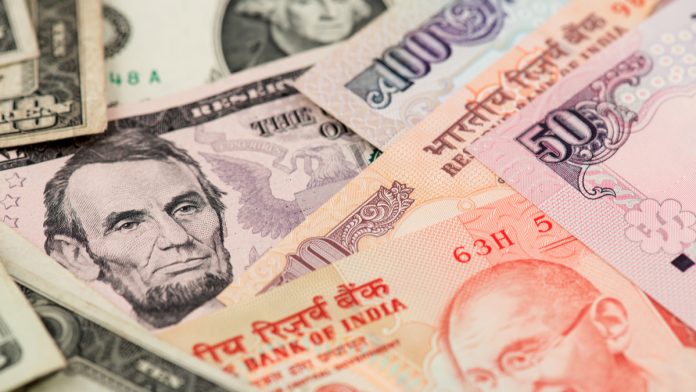- Indian Rupee (INR) is inching higher
- RBI reserves reach a record high
- US Dollar (USD) is falling against its peers
- Core PCE data remained at 2.6%
The US Dollar Indian Rupee (USD/INR) exchange rate fell modestly after three days of gains. The pair rose 0.01% in the previous session, settling on Thursday at 83.72. At 19:00 UTC, USD/INR trades -0.04% at 83.72 and is in a range of 83.76 to 83.77. The pair is on track to fall 0.03% this week after three weeks of gains.
Indian foreign exchange reserves rose for a third consecutive week, reaching a record high of $670.86 billion as of July 19.
The data from the Reserve Bank of India shows that reserves climbed by $4 billion in the relevant week after rising a total of $14.9 billion in the previous two weeks.
Changes in foreign currency assets are caused by the Reserve Bank of India’s intervention in the FX market and the appreciation or depreciation of foreign assets held.
Meanwhile, weaker oil prices have also been supporting the Rupee. Oil prices fell for a third straight week on concerns regarding the outlook for Chinese demand and optimism about a ceasefire in the Middle East in Gaza.
The US Dollar fell across the board on Friday. The US Dollar Index, which measures the greenback versus a basket of major currencies, trades -0.04% at the time of writing at 104.33, after gains in the previous session.
The US dollar fell on Friday as investors digested the latest core PCE data, the Federal Reserve’s preferred gauge of inflation.
Core PCE was slightly stickier than expected at 2.6% year on year in July in June, unchanged from May and slightly higher than the 2.5% year-on-year increase that economists had forecast.
On a monthly basis core PCE rose 0.2% month on month ahead of the 0.1% forecast.
Meanwhile, the personal shopping gauge showed that spending held up in June, rising 0.2%, while May’s personal spending was also upwardly revised. This points to encouraging signs that the Fed’s tighter monetary policy is working its way through the economy but not causing too much damage.
The data comes ahead of next week’s FOMC meeting, at which the Fed is likely to signal a September rate cut.
The market is pricing in several rate cuts before the end of the year with the first one expected in September and potentially another in November and or December.





